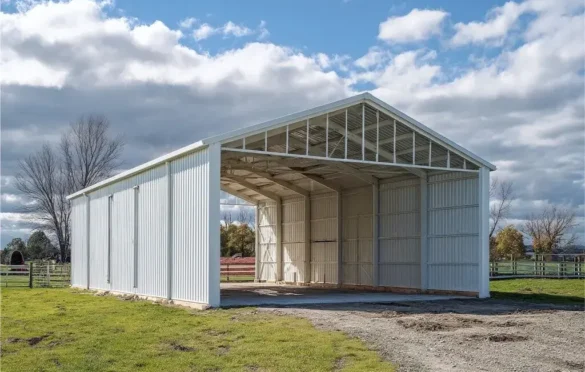Explore this post with:
Are you designing and building your dream home? Perhaps you’re renovating a house you’ve just purchased, to better reflect your style. Don’t forget to include sustainability in your plans. A greener home will reduce your energy costs, saving you lots of money long term. And it’s good for the environment, too.
Here are 5 design tips for a greener, more efficient home.
Tip 1: Use Sustainable Building Materials
Choose low-impact, sustainably sourced materials for building your home. This is just as important if you are building onto an existing structure.
If the materials are made from recycled or reclaimed wood and steel, you’re doing even more for the eco-friendly cause. Bamboo is also an eco-friendly material, prized for its sustainability, durability, and strength.
Sustainable building materials don’t just reduce the environmental impact of construction. They also create a healthier home environment, for you and your family to live in.
Tip 2: Optimize Insulation and Sealing
Good insulation and sealing are crucial for energy efficiency. The outer walls, roof, floors, doors, and windows of a property are known as a building envelope. They collectively seal, insulate, and protect what is inside the structure. And when that envelope is not sufficiently sealed and insulated, things go wrong.
Water can make its way into ceilings and walls, and lead to mold and mildew, or into wood floors, causing them to warp. Ill-fitting doors and windows can cause unpleasant drafts and a loss of heat in winter. These problems have serious consequences for quality of life, as they impact your health and comfort.
Even worse, they cost you money, not only in repairs for damaged property but also in high energy bills. It’s a lot more difficult to keep a home cool in summer, and warm in winter, without good insulation and sealing.
So take action, and get a whole of home assessment done. It will pinpoint the areas needing improvement, so you can enjoy energy savings and a greener home.
Tip 3: Incorporate Energy-Efficient Windows and Doors
Once you know how important doors and windows are for energy efficiency, it’s time to do something about it. The latest energy-efficient doors and windows will maximize the energy efficiency of your home envelope.
Well-sealing doors and windows prevent air leaks that allow heat to escape. Dual-pane glass windows provide extra insulation from both heat and cold. And low-emissivity glass reduces ultraviolet (UV) and infrared light, to counteract heat transfer.
Your heating and cooling needs will differ, depending on your location and climate. But wherever you live, it’s important to make the most of natural light. You can do this with more strategic positioning of windows. By harnessing the natural light, you reduce reliance on daytime indoor lighting.
Here’s a bonus tip: Thermal curtains keep your home even cozier.
Tip 4: Integrate Renewable Energy Solutions
Invest in renewable energy solutions and you’ll drive your utility costs down even further. But be sure to do your research first, to ensure accurate placement and use for maximum benefits.
Solar panels are widely available, and save thousands of dollars a year on electricity. What’s more, they reduce reliance on the grid in peak periods and add value to your home. Some regions offer incentives for implementing renewable energy. This is why modern homes are designed for renewable energy use.
Investigate whether geothermal heating or wind turbines are an option where you live. They, too, can lower your energy expenses while reducing your carbon footprint. That’s good news for your wallet and the planet!
Tip 5: Install Efficient Lighting and Appliances
Your choice of light fixtures and appliances can make or break your efforts for a greener, more efficient home — choose them wisely.
Compact fluorescent lamps (CFL) use only a quarter of the energy of incandescent bulbs, yet last much longer. But check the FDA’s guidelines for CFL use. Light-emitting diode (LED) bulbs last even longer. They also lose less energy through heat, and convert more electricity into light, than conventional bulbs.
Modern appliances like refrigerators, dishwashers, and cooktops that have good Energy Star ratings use less electricity and water than their older counterparts. Remember to check every major appliance’s Energy Star rating before purchasing.
Want even more energy savings in your home? Install Smart devices that can regulate the lights, and appliances in your home. They can also control your thermostat for more effective heating and cooling.
Final Thoughts
There are many benefits to having a greener, more efficient home.
Sustainable building materials, optimized insulation and sealing, and energy-wise windows and doors will create a sustainable, eco-friendly, and energy-efficient home envelope. This will prevent issues that lead to illness and property damage, and improve energy efficiency.
More efficient lighting and appliances will save you money on all your utility bills. Renewable energy solutions will cut costs even further by reducing your reliance on an already burdened power grid. This is even better news for the environment.
Implement as many of these tips as you can, to maximize the benefits.
In case you missed!
About the Author: archistyladmin
At Architecturesstyle, we’re passionate about smart design, beautiful spaces, and practical tips that help you bring great architecture into everyday life. Whether it's modern home ideas, iconic buildings, or expert advice, our team brings fresh and useful content to readers who love architecture as much as we do.




